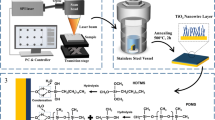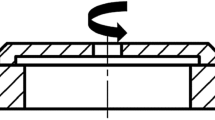Abstract
Oil film vortex severely reduces the stability of hydrostatic bearings. A solid-liquid interface with drag and slip properties can weaken the oil film vortex of the bearing. Here, a combined picosecond laser ablation and chemical modification method is proposed to prepare surfaces with microbulge array structure on 6061 aluminum alloy substrates. Because of the low surface energy of the perfluorododecyltriethoxysilane modification and the bulge geometry of the microbulge array structure, the surface shows excellent superhydrophobicity. The optimum contact angle in air for water is 164°, and that for oil is 139°. Two surfaces with “lotus-leaf effect” and “rose-petal effect” were obtained by controlling the processing parameters. The drag reduction properties of superhydrophobic surfaces were systematically investigated with slip lengths of 22.26 and 36.25 µm for deionized water and VG5 lubricant, respectively. In addition, the superhydrophobic surface exhibits excellent mechanical durability and thermal stability. The proposed method provides a new idea for vortex suppression in hydrostatic bearings and improves the stability of bearings in high-speed operation.
Similar content being viewed by others
References
Huang Y, Cao H Y, Tian Z X. Stability analysis of long hydrodynamic journal bearings based on the journal center trajectory. Friction, 2021, 9: 1776–1783
Du J, Liang G. Dynamic coefficients and stability analysis of a water-lubricated hydrostatic bearing by solving the uncoupled Reynolds equation. Chin J Aeronautics, 2020, 33: 2110–2122
Ramos D J, Daniel G B. A new concept of active hydrodynamic bearing for application in rotating systems. Tribol Int, 2021, 153: 106592
Aurelian F, Patrick M, Mohamed H. Wall slip effects in (elasto) hydrodynamic journal bearings. Tribol Int, 2011, 44: 868–877
Rao T. Theoretical prediction of journal bearing stability characteristics based on the extent of the slip region on the bearing surface. Tribol Trans, 2009, 52: 750–758
Bhattacharya A, Dutt J K, Pandey R K. Influence of hydrodynamic journal bearings with multiple slip zones on rotordynamic behavior. J Tribol, 2017, 139: 061701
Li W L, Huang Z H, Lin C S, et al. On the linear stability analysis of journal bearings—Consideration of coupled effects of anisotropic slip and surface roughness. Tribol Int, 2019, 137: 254–266
Phani Kumar M, Samanta P, Murmu N C. Rigid rotor stability analysis on finite hydrostatic double-layer porous oil journal bearing with velocity slip. Tribol Trans, 2015, 58: 930–940
Rao T, Rani A M A, Awang M, et al. Stability evaluation of three-layered journal bearing with slip/partial slip. Ind Lub Tribol, 2017, 69: 334–341
Sharma S C, Jamwal G, Awasthi R K. Dynamic and stability performance improvement of the hydrodynamic bearing by using triangular-shaped textures. P I Mech Eng J-J Eng, 2020, 234: 1436–1451
Zhao X, Xue Y, Yang H, et al. Drag reduction effect of ultraviolet laser-fabricated superhydrophobic surface. Surf Eng, 2020, 36: 1307–1314
Rong W, Zhang H, Mao Z, et al. Stable drag reduction of anisotropic superhydrophobic/hydrophilic surfaces containing bioinspired micro/nanostructured arrays by laser ablation. Colloid Surfs A-Physicochem Eng Aspects, 2021, 622: 126712
Ko Y S, Kim H J, Ha C W, et al. Quantifying frictional drag reduction properties ofsuperhydrophobic metal oxide nanostructures. Langmuir, 2020, 36: 11809–11816
Chen Q, Duan J, Hou Z, et al. Effect of the surface pattern on the drag property of the superhydrophobic surface. Phys Fluids, 2022, 34: 114113
Lin Y, Han J, Cai M, et al. Durable and robust transparent super-hydrophobic glass surfaces fabricated by a femtosecond laser with exceptional water repellency and thermostability. J Mater Chem A, 2018, 6: 9049–9056
Saadatbakhsh M, Jamali Asl S, Kiani M J, et al. Slip length measurement of pdms/hydrophobic silica superhydrophobic coating for drag reduction application. Surf Coat Tech, 2020, 404: 126428
Lian Z, Cheng Y, Liu Z, et al. Scalable fabrication of super-hydrophobic armor microstructure arrays with enhanced tribocorrosion performance via maskless electrochemical machining. Surf Coat Tech, 2023, 461: 129427
Wu C Y, Rong Y M, Huang Y, et al. Laser cutting of thermoplastic film: Mechanism and processing technology. Sci China Tech Sci, 2022, 65: 2068–2078
Zhang X N, Gan L, Sun B, et al. Bio-inspired manufacturing of superwetting surfaces for fog collection and anti-icing applications. Sci China Tech Sci, 2022, 65: 1975–1994
Guo M H, Zhang G J, Xin G Q, et al. Laser direct writing of rose petal biomimetic micro-bulge structure to realize superhydrophobicity and large slip length. Colloid Surfs A-Physicochem Eng Aspects, 2023, 664: 130972
Wang X L, Wang H Y, Liu Y D, et al. Improvement of multi-functional properties by fabricating micro-pillar arrays structures on zirconium alloy surface. Sci China Tech Sci, 2022, 65: 1243–1252
Ju G, Zhou L, Li J, et al. Robust metallic-based superhydrophobic composite with rigid micro-skeleton structure for anti-icing/frosting. J Mater Process Tech, 2023, 316: 117916
Wang D, Sun Q, Hokkanen M J, et al. Design of robust super-hydrophobic surfaces. Nature, 2020, 582: 55–59
Latthe S, Terashima C, Nakata K, et al. Superhydrophobic surfaces developed by mimicking hierarchical surface morphology of lotus leaf. Molecules, 2014, 19: 4256–4283
Yang J, Long F, Wang R, et al. Design of mechanical robust super-hydrophobic Cu coatings with excellent corrosion resistance and self-cleaning performance inspired by lotus leaf. Colloid Surfs A-Physicochem Eng Aspects, 2021, 627: 127154
Li L, Huang T, Lei J, et al. Robust biomimetic-structural super-hydrophobic surface on aluminum alloy. ACS Appl Mater Interfaces, 2015, 7: 1449–1457
Sahoo B N, Kandasubramanian B. Recent progress in fabrication and characterisation of hierarchical biomimetic superhydrophobic structures. RSC Adv, 2014, 4: 22053–22093
Koch K, Barthlott W. Superhydrophobic and superhydrophilic plant surfaces: An inspiration for biomimetic materials. Phil Trans R Soc A, 2009, 367: 1487–1509
Chen T, Liu H, Yang H, et al. Biomimetic fabrication of robust self-assembly superhydrophobic surfaces with corrosion resistance properties on stainless steel substrate. RSC Adv, 2016, 6: 43937–43949
Yang Y, Li X, Zheng X, et al. 3D-Printed biomimetic super-hydrophobic structure for microdroplet manipulation and oil/water separation. Adv Mater, 2018, 30: 1704912
Liu Y, Li X, Jin J, et al. Anti-icing property of bio-inspired microstructure superhydrophobic surfaces and heat transfer model. Appl Surf Sci, 2017, 400: 498–505
Lin J, Cai Y, Wang X, et al. Fabrication of biomimetic super-hydrophobic surfaces inspired by lotus leaf and silver ragwort leaf. Nanoscale, 2011, 3: 1258–1262
Zhang X, Liu Z, Li Y, et al. Durable superhydrophobic surface prepared by designing “micro-eggshell” and “web-like” structures. Chem Eng J, 2020, 392: 123741
Gao R, Liu Q, Wang J, et al. Fabrication of fibrous szaibelyite with hierarchical structure superhydrophobic coating on AZ31 magnesium alloy for corrosion protection. Chem Eng J, 2014, 241: 352–359
Wang Y D, Xu Z Y, Zhang A, et al. Surface morphology and electrochemical behaviour of Ti-48Al-2Cr-2Nb alloy in low-concentration salt solution. Sci China Tech Sci, 2021, 64: 283–296
Shang H M, Wang Y, Limmer S J, et al. Optically transparent superhydrophobic silica-based films. Thin Solid Films, 2005, 472: 37–43
Badre C, Pauporté T, Turmine M, et al. Water-repellent ZnO nanowires films obtained by octadecylsilane self-assembled monolayers. Physica E-Low-dimensional Syst NanoStruct, 2008, 40: 2454–2456
Öner D, McCarthy T J. Ultrahydrophobic surfaces effects of topography length scales on wettability. Langmuir, 2000, 16: 7777–7782
Wang Q, Liu Y, Jiang L, et al. Metal micro/nanostructure enhanced laser-induced breakdown spectroscopy. Anal Chim Acta, 2023, 1241: 340802
Zheng B, Jiang G, Wang W, et al. Fabrication of superhydrophilic or superhydrophobic self-cleaning metal surfaces using picosecond laser pulses and chemical fluorination. Radiat Effects Defects Solids, 2016, 171: 461–473
Pan Q, Cao Y, Xue W, et al. Picosecond laser-textured stainless steel superhydrophobic surface with an antibacterial adhesion property. Langmuir, 2019, 35: 11414–11421
Mao Z, Cao W, Hu J, et al. A dual-functional surface with hierarchical micro/nanostructure arrays for self-cleaning and antireflection. RSC Adv, 2017, 7: 49649–49654
Wu W, Wang J, Liu Q, et al. Electrochemical polishing assisted selective laser melting of biomimetic superhydrophobic metallic parts. Appl Surf Sci, 2022, 596: 153601
Ahmmed K, Kietzig A M. Drag reduction on laser-patterned hierarchical superhydrophobic surfaces. Soft Matter, 2016, 12: 4912–4922
Lee C, Kim C J. Maximizing the giant liquid slip on superhydrophobic microstructures by nanostructuring their sidewalls. Langmuir, 2009, 25: 12812–12818
Ahmmed KMT, Patience C, Kietzig A M. Internal and external flow over laser-textured superhydrophobic polytetrafluoroethylene (PTFE). ACS Appl Mater Interfaces, 2016, 8: 27411–27419
Lee C, Choi C H, Kim C J. Structured surfaces for a giant liquid slip. Phys Rev Lett, 2008, 101: 064501
Wang S Y, Ren Y, Cheng C W, et al. Micromachining of copper by femtosecond laser pulses. Appl Surf Sci, 2013, 265: 302–308
Long J, Pan L, Fan P, et al. Cassie-state stability of metallic super-hydrophobic surfaces with various micro/nanostructures produced by a femtosecond laser. Langmuir, 2016, 32: 1065–1072
Oopath S V, Baji A, Abtahi M. Biomimetic rose petal structures obtained using UV-nanoimprint lithography. Polymers, 2022, 14: 3303
Lai Y, Huang J, Gong J, et al. Superhydrophilic-superhydrophobic template: A simple approach to micro- and nanostructure patterning of TiO2 films. J Electrochem Soc, 2009, 156: D480
Hao L, Yu S, Han X, et al. Design of submicron structures with superhydrophobic and oleophobic properties on zinc substrate. Mater Des, 2015, 85: 653–660
Amoruso S, Ausanio G, Bruzzese R, et al. Characterization of laser ablation of solid targets with near-infrared laser pulses of 100 fs and 1 ps duration. Appl Surf Sci, 2006, 252: 4863–4870
Gao X, Jiang L. Water-repellent legs of water striders. Nature, 2004, 432: 36
Wang Q, Xu S, Xing X, et al. Progress in fabrication and applications of micro/nanostructured superhydrophobic surfaces. Surf Innovations, 2022, 10: 89–110
Aboud D G K, Kietzig A M. Influence of microstructure topography on the oblique impact dynamics of drops on superhydrophobic surfaces. Langmuir, 2021, 37: 4678–4689
Jia J, Fan J F, Xu B S, et al. Microstructure and properties of the super-hydrophobic films fabricated on magnesium alloys. J Alloys Compd, 2013, 554: 142–146
Li H, Yu S R, Han X X. Preparation of a biomimetic super-hydrophobic ZnO coating on an X90 pipeline steel surface. New J Chem, 2015, 39: 4860–4868
Wenzel R N. Resistance of solid surfaces to wetting by water. Ind Eng Chem, 1936, 28: 988–994
Bormashenko E. Progress in understanding wetting transitions on rough surfaces. Adv Colloid Interface Sci, 2015, 222: 92–103
Cassie A B D, Baxter S. Wettability ofporous surfaces. Trans Faraday Soc, 1944, 40: 546–551
Wenzel R N. Surface roughness and contact angle. J Phys Chem, 1949, 53: 1466–1467
Wang K, Zhang Y, Yu Y, et al. Simulation of boundary slip on a liquid-solid surface based on the lattice Boltzmann method. ScienceAsia, 2015, 41: 130–135
Maali A, Bhushan B. Measurement of slip length on super-hydrophobic surfaces. Phil Trans R Soc A, 2015, 370: 2304–2320
Srinivasan S, Choi W, Park K C, et al. Drag reduction for viscous laminar flow on spray-coated non-wetting surfaces. Soft Matter, 2013, 9: 5691–5702
Fukagata K, Kasagi N, Koumoutsakos P. A theoretical prediction of friction drag reduction in turbulent flow by superhydrophobic surfaces. Phys Fluids, 2006, 18: 051703
Author information
Authors and Affiliations
Corresponding author
Additional information
This work was supported by the National Key R&D Program of China (Grant No. 2020YFB2007600), National Natural Science Foundation of China (Grant Nos. 51875223 and 52188102), and Guangdong HUST Industrial Technology Research Institute, Guangdong Provincial Key Laboratory of Manufacturing Equipment Digization (Grant No. 2020B1212060014).
Supporting Information
The supporting information is available online at tech.scichina.com and link.springer.com. The supporting materials are published as submitted, without typesetting or editing. The responsibility for scientific accuracy and content remains entirely with the authors.
Supporting information
Supplementary material, approximately 2.63 MB.
Supplementary material, approximately 3.05 MB.
Supplementary material, approximately 857 MB.
Supplementary material, approximately 686 MB.
Rights and permissions
About this article
Cite this article
Guo, M., Rong, Y., Huang, Y. et al. Ultrafast laser-chemical modification hybrid fabrication of hydrostatic bearings with a superhydrophobicity solid-liquid interface. Sci. China Technol. Sci. 67, 696–708 (2024). https://doi.org/10.1007/s11431-023-2573-1
Received:
Accepted:
Published:
Issue Date:
DOI: https://doi.org/10.1007/s11431-023-2573-1




